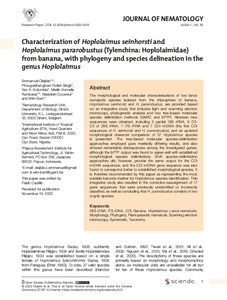| dc.contributor.author | Olajide, E. |
| dc.contributor.author | Singh, P.R. |
| dc.contributor.author | Kolombia, Y.A. |
| dc.contributor.author | Rumbarar, M.K. |
| dc.contributor.author | Couvreur, M. |
| dc.contributor.author | Bert, W. |
| dc.date.accessioned | 2023-09-25T09:38:16Z |
| dc.date.available | 2023-09-25T09:38:16Z |
| dc.date.issued | 2023-05-23 |
| dc.identifier.citation | Olajide, E., Singh, P.R., Kolombia, Y.A., Rumbarar, M.K., Couvreur, M. & Bert, W. (2023). Characterization of Hoplolaimus seinhorsti and Hoplolaimus pararobustus (Tylenchina: Hoplolaimidae) from banana, with phylogeny and species delineation in the genus Hoplolaimus. Journal of Nematology, 55(1), 1-24. |
| dc.identifier.issn | 0022-300X |
| dc.identifier.uri | https://hdl.handle.net/20.500.12478/8258 |
| dc.description.abstract | The morphological and molecular characterisations of two lance nematode species isolated from the rhizosphere of banana, Hoplolaimus seinhorsti and H. pararobustus, are provided based on an integrative study that includes light and scanning electron microscopy, phylogenetic analysis and two tree-based molecular species delimitation methods (GMYC and bPTP). Nineteen new sequences were obtained, including 5 partial 18S rRNA, 6 D2-D3 of 28S rRNA, 1 ITS rRNA and 7 COI mtDNA (the first COI sequences of H. seinhorsti and H. pararobustus), and an updated morphological character comparison of 37 Hoplolaimus species is presented. The tree-based molecular species-delimitation approaches employed gave markedly differing results, and also showed remarkable discrepancies among the investigated genes, although the bPTP output was found to agree well with established morphological species delimitations. Both species-delimitation approaches did, however, provide the same output for the COI mtDNA sequences, and the COI mtDNA gene sequence was also found to correspond better to established morphological species. It is therefore recommended by this paper as representing the most suitable barcode marker for Hoplolaimus species identification. This integrative study also resulted in the corrective reassignment of 17 gene sequences that were previously unidentified or incorrectly classified, as well as concluding that H. pararobustus consists of two cryptic species. |
| dc.format.extent | 1-24 |
| dc.language.iso | en |
| dc.subject | Bananas |
| dc.subject | Hoplolaimus |
| dc.subject | Nematodes |
| dc.subject | Morphology |
| dc.subject | Phylogeny |
| dc.subject | Plant Nematodes |
| dc.subject | Taxanomy |
| dc.subject | DNA |
| dc.title | Characterization of Hoplolaimus seinhorsti and Hoplolaimus pararobustus (Tylenchina: Hoplolaimidae) from banana, with phylogeny and species delineation in the genus Hoplolaimus |
| dc.type | Journal Article |
| cg.contributor.crp | Roots, Tubers and Bananas |
| cg.contributor.affiliation | Ghent University |
| cg.contributor.affiliation | International Institute of Tropical Agriculture |
| cg.contributor.affiliation | Papua Assessment Institute for Agricultural Technology |
| cg.coverage.region | Africa |
| cg.coverage.region | West Africa |
| cg.coverage.country | Nigeria |
| cg.coverage.hub | Headquarters and Western Africa Hub |
| cg.identifier.bibtexciteid | OLAJIDE:2023a |
| cg.isijournal | ISI Journal |
| cg.authorship.types | CGIAR and advanced research institute |
| cg.iitasubject | Agronomy |
| cg.iitasubject | Banana |
| cg.iitasubject | Disease Control |
| cg.iitasubject | Food Security |
| cg.iitasubject | Genetic Improvement |
| cg.iitasubject | Plant Breeding |
| cg.iitasubject | Plant Diseases |
| cg.iitasubject | Plant Ecology |
| cg.iitasubject | Plant Genetic Resources |
| cg.iitasubject | Plant Health |
| cg.iitasubject | Plant Production |
| cg.journal | Journal of Nematology |
| cg.notes | Open Access Article; Published online: 23 May 2023 |
| cg.accessibilitystatus | Open Access |
| cg.reviewstatus | Peer Review |
| cg.usagerightslicense | Creative Commons Attribution-NonCommercial-NoDerivatives 4.0 (CC BY-NC-ND 4.0) |
| cg.targetaudience | Scientists |
| cg.identifier.doi | https://doi.org/10.2478/jofnem-2023-0019 |
| cg.futureupdate.required | No |
| cg.identifier.issue | 1 |
| cg.identifier.volume | 55 |

